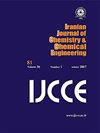水泥回转窑涂层厚度的识别
IF 1.3
4区 工程技术
Q4 CHEMISTRY, MULTIDISCIPLINARY
Iranian Journal of Chemistry & Chemical Engineering-international English Edition
Pub Date : 2021-07-05
DOI:10.30492/IJCCE.2021.131568.4248
引用次数: 0
摘要
水泥工业是每个国家的主要工业之一。这个行业是一个国家发展的动力。这个行业的核心是回转窑。关于回转窑的一个重要问题是在窑的内壁上形成一层熔化的材料,称为涂层。这种涂层的厚度低,会造成耐火砖烧壁和对窑炉的严重破坏,而其厚度高,则会降低产品的产量和质量。目前,窑炉由经验丰富的技术人员检查,以进行经验性的涂层估计。本文的目的是为了实现窑炉的自动控制,对涂层厚度进行识别。涂层厚度的识别问题是基于窑内不同层间的热阻和各层间的传热方程。为此,使用了普通最小二乘法(OLS)、递归最小二乘法(RLS)、全局搜索法和遗传算法等线性和非线性识别方法。在提出的识别方法中,可以通过窑的环境和内部固体温度曲线来识别涂层。在给定的固体温度分布、不同窑型和不同窑层厚度的条件下,通过有限元分析(FEA)提取了识别过程的原始数据。本文的建模和仿真结果表明,该识别方法能够在不同方法可接受的误差范围内确定涂层量。本文章由计算机程序翻译,如有差异,请以英文原文为准。
Identification of Coating Thickness in Cement Rotary Kiln
The cement industry is one of the major industries in every country. This industry is the driving force behind the development of a nation. The heart of this industry is the rotary kiln. One of the significant concerns about a rotary kiln is forming a cover of molten materials on the kiln's inner wall called coating. The low thickness of this coating cause burns to the wall refractory bricks and heavy damage to the kiln, while its high thickness reduces the production volume and quality of products. Currently, the kilns are checked by experienced technicians for empirical coating estimation. This paper aims to identify the thickness of the coating for the automatic control purpose of the kiln. The identification problem of coating thickness is based on thermal resistances in different layers of the kiln and heat transfer equations between these layers. For this purpose, the linear and nonlinear identification methods such as Ordinary Least Squares (OLS), Recursive Least Squares (RLS), global search method, and genetic algorithm are used. The coating can be identified in the proposed identification approach by having the kiln's ambient and internal solid temperature profiles. The raw data for the identification process has been extracted by Finite Element Analysis (FEA) for a given solid temperature profile along with the kiln and different kiln coating thicknesses. The modeling and simulations carried out in this paper show that the identification methods were able to determine the amount of coating with acceptable errors depending on the method.
求助全文
通过发布文献求助,成功后即可免费获取论文全文。
去求助
来源期刊

Iranian Journal of Chemistry & Chemical Engineering-international English Edition
CHEMISTRY, MULTIDISCIPLINARY-ENGINEERING, CHEMICAL
CiteScore
2.80
自引率
22.20%
发文量
0
审稿时长
6-12 weeks
期刊介绍:
The aim of the Iranian Journal of Chemistry and Chemical Engineering is to foster the growth of educational, scientific and Industrial Research activities among chemists and chemical engineers and to provide a medium for mutual communication and relations between Iranian academia and the industry on the one hand, and the world the scientific community on the other.
 求助内容:
求助内容: 应助结果提醒方式:
应助结果提醒方式:


